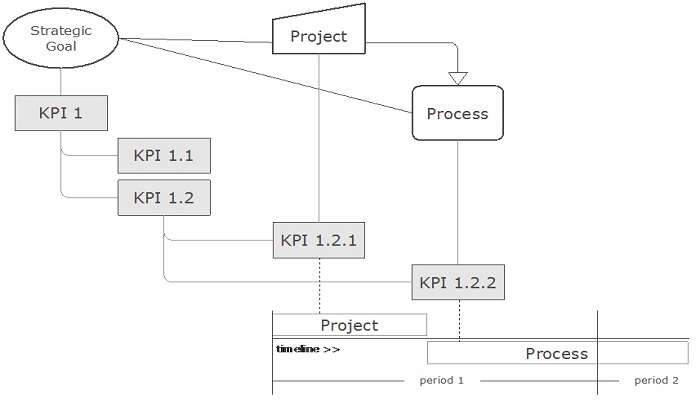

Some organisations, after straggling to implement Balanced Scorecard Systems (BSC), come to the conclusion that they need to at least map their processes. But then the challenge they face is how to link strategic with process KPIs. Others are practising some sort of BPM but have difficulties demonstrating its contribution to the bottom line. As Anatoly Belychook recently wrote:
business consultants know what should be done eventually but have vague understanding of how strategic goals can be achieved with the help of BPM
There are many ways to do that. One of them, usable in the ‘ordered’ domains, is to include process KPIs in the formula of certain KPI (or ‘KGI’, to conform CobiT’s terminology) of a strategic goal. It’s simple but not so straightforward so let’s first have the bigger picture.
There are basically three types of things in the motivational domain: goals, means and influencers. (If you need to dig deeper, Nick Malik’s EBMM is a good place for that. Interestingly, one of the things that had driven that extension to the BMM was the work of Alexander Osterwalder, one of the authors of the now popular Business Model Generation book) The means to achieve most ends, especially of those belonging to the classic ‘process’ perspective of the BSC, either require certain change to be managed or some parameter(s) to be kept within desirable range or both. Let’s illustrate this by combining it in a single case where a strategic goal is supported by certain process which is no yet implemented. Thus there will be another ‘means’ representing the project to implement that process.
KPIs are either primary or derived. In the example, the strategic goal is measured by a KPI 1 (derived) which is calculated by the value of KPI 1.1 (primary), KPI 1.2 (derived) and some specific attribute of their relations like weighting for example. KPI 1.2 is calculated from the values of the project KPI 1.2.1 and the process KPI 1.2.2. They are in reality more than one for both project and process management. If the project duration is shorter than the control frequency of the strategic goal, then for ‘period 1′ KPI 1.2 will take KPI 1.2.1 and KPI 1.2.2 value times their respective weighting. For ‘period 2′ KPI 1.2.1 will be equal to the value of KPI 1.2.2.
Such an approach needs the support of a repository based tool for modelling and analysis. No matter if its primary focus is EA or BPM, it should support enterprise motivational domain and ideally project and program management.
Source: http://www.strategicstructures.com/?p=314